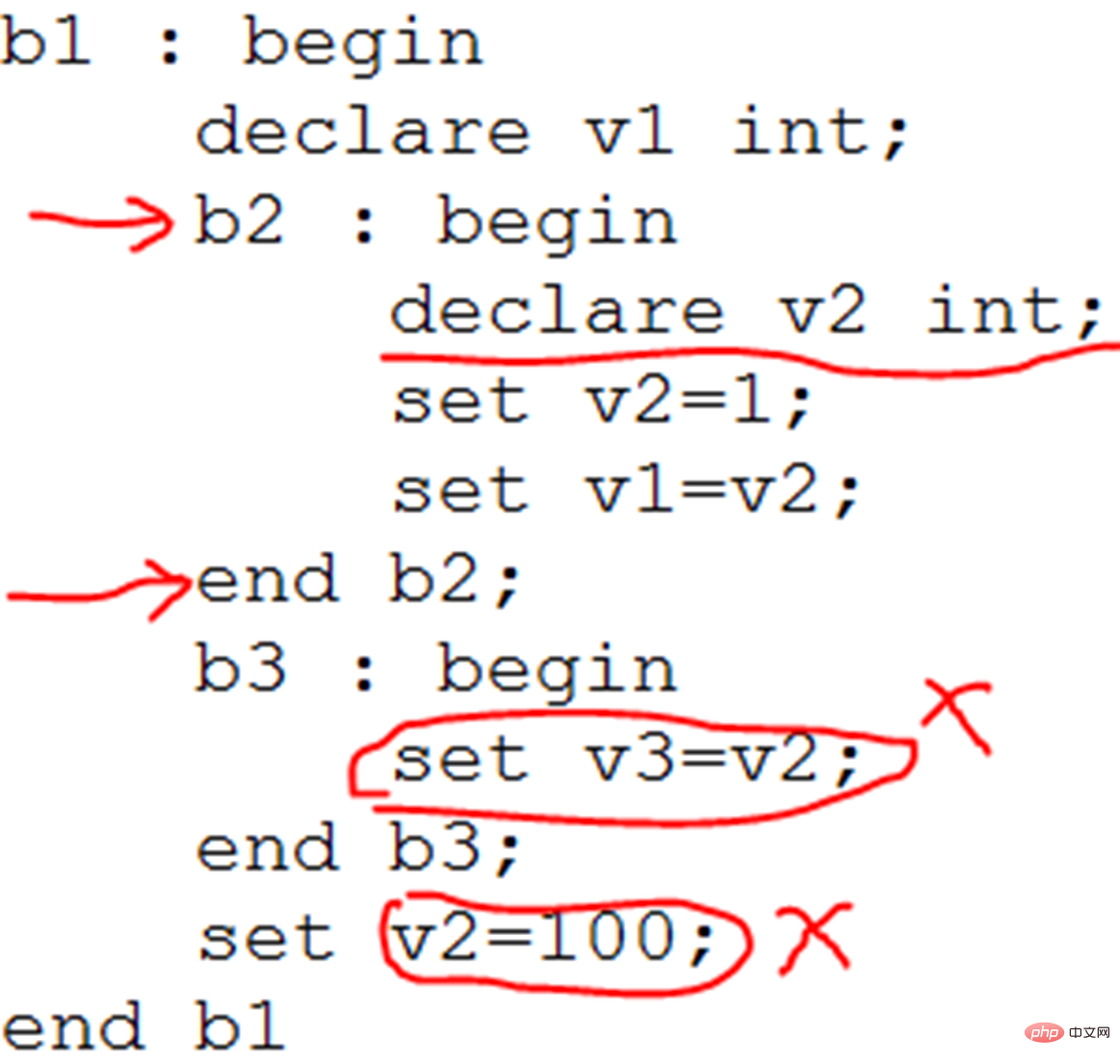What variable types do mysql stored procedures have?
Variable types of mysql stored procedures: 1. Local variables, the definition syntax is "DECLARE variable name data type"; 2. User variables, the definition syntax is "set @variable name:=..."; 3 , system variables, which can be divided into global variables "@@global" and session variables "@@session".

The operating environment of this tutorial: windows10 system, mysql8.0.22 version, Dell G3 computer.
What are the variable types of mysql stored procedures?
Common variables in MySQL stored procedures: local variables, user variables, system variables
1. Local variables
In the process body, you can declare local variables to temporarily save some values.
1. Syntax for defining local variables:
DECLARE var_name[, var_name] ... type [DEFAULT value];
Among them, type is the data type of MySQL, such as: int, float, date, varchar(length)
Note:
①DECLARE is used to declare local variables, and DECLARE is only used in BEGIN ... END compound statements, and must be at the beginning of the compound statement, before any other statements; it can be used in nested blocks , except those blocks that declare variables with the same name.
② If you want to provide a default value for a variable, use the DEFAULT clause (the value can be a constant or specified as an expression); if there is no DEFAULT clause, the initial value is NULL.
2. Basic format:
CREATE PROCEDURE sp_name ([proc_parameter[,...]]) BEGIN DECLARE var_name1 type [DEFAULT value]; DECLARE var_name2 type [DEFAULT value]; DECLARE……; [characteristic ...];
Example 1: Create a process, specify default values for local variables, and call the process
mysql>delimiter $$ mysql> create procedure test1(out num1 int)->begin-> declare num2 int default 100;-> set num1=num2;->end->$$ mysql>delimiter ; mysql>call test1(@num); mysql> select@num;+------+ | @num | +------+ | 100 | +------+
Analysis:
Create the test1 stored procedure: the output is the value of the num1 variable. Declare the local variable num2 to be of int type and the default value is 100. Use set to assign the value of num2 (if not processed, the default value) to num1;
Call test1: Use the user variable num to receive the output value num1 of the stored procedure...
In addition to literal values, the default value can also be a complex expression, including a scalar subquery
Example 2: Creation process, using the number of all players to initialize a variable
mysql>delimiter $$ mysql> create procedure test2(out num1 int)->begin-> declare num2 int default(select count(*) fromPLAYERS);-> set num1=num2;->end$$mysql>delimiter ; mysql>call test2(@num);mysql> select@num;+------+ | @num | +------+ | 14 | +------+
Note: MySQL does not support arrays as local variables.
3. The scope of local variables:
That is, the scope of the program block where the variable can be used normally without errors.
In the case of nested blocks,
Variables declared in the outer block can be used directly in the inner block;
Variables declared in the inner block can only Used inside blocks.

Analysis: Variable v2 can only be used in internal block b2. The set statement and the last set statement in block b3 are wrong.
2. User variables
>User variables are related to the database connection: variables declared in the current connection will disappear when the connection is disconnected; Variables declared in this connection cannot be used in another connection.
>An @ symbol represents a user variable.
1. Definition of user variables (set, select):
1) The set statement assigns values to user variables:
You can use "=" or ":=" as Assignment character;
The expr assigned to each variable can be an integer, real number, string or NULL value;
mysql> set @zjc:=999; mysql> select@zjc;+------+ | @zjc | +------+ | 999 | +------+
2) The select statement assigns a value to the user variable:
The allocation operator must be ":=" instead of "=", because = is regarded as a comparison operator in non-SET statements;
mysql> select @abc:=123;+-----------+ | @abc:=123 | +-----------+ | 123 | +-----------+mysql> select@abc;+------+ | @abc | +------+ | 123 | +------+
Note:
① User variables can be used anywhere If defined, it can be used anywhere; if not defined, it can be used directly (the value defaults to null).
②The format of the variable name of user variables: @var_name, with the @ symbol.
③Abuse of user variables will make the program difficult to understand and manage.
Extended variable assignment: set syntax
The variables in MySQL do not strictly limit the data type. The data type of the variable changes at any time according to the value assigned to the variable.
SET variable_assignment [, variable_assignment] ... variable_assignment: user_var_name=expr|[GLOBAL | SESSION] system_var_name =expr|[@@global. | @@session. | @@] system_var_name = expr
## is used to assign values to user variables, system variables, and can also assign values to local variables in the process.
Note:
When setting system variables, there is no scope modification, and the default refers to the session scope;
(Special note, some system variables do not have scope modification , cannot be set, so it is best to set system variables with scope).
2. The scope of user variables
As long as the user variables defined in the current connection are used in the current connection, it is OK, but nothing else.
3. Difference from local variables:
Local variables only have variable names and no @ symbol; user variable names have @ symbol before them.
They are defined first and then used; for undefined variables, the select value is empty.
Local variables are only used inside the stored procedure and have no meaning outside the process. When the begin-end block is processed, the local variables disappear; while user variables can be used inside and outside the stored procedure.
Tips: Inside the stored procedure, use local variables instead of user variables.
3. User variables and system variables of MySQL variables
1. User variables are as mentioned above@var_name (an @ symbol)
①User Variables are related to the database connection. They are declared after the connection and disappear automatically after the connection is disconnected;
②Select a user variable without assignment and return NULL, that is, no value;
Mysql variables are similar to dynamic languages, and the value of the variable changes with the type of value to be assigned.
2. System variables: According to the scope of system variables, they are divided into: global variables and session variables (two @ symbols)
①Global variables (@@global.)
When MySQL starts, the server automatically initializes global variables to their default values;
The default values of global variables can be changed by changing the MySQL configuration file (my.ini, my.cnf).
②Session variables (@@session.)
Every time a new connection is established, it is initialized by MySQL;
MYSQL will store all current global variables Copy the value as a session variable (that is, if the values of the session variable and global variable are not manually changed after the session is established, the values of all these variables will be the same).
#The difference between global variables and session variables: Modifications to global variables will affect the entire server, but modifications to session variables will only affect the current session.
Recommended learning: mysql video tutorial
The above is the detailed content of What variable types do mysql stored procedures have?. For more information, please follow other related articles on the PHP Chinese website!

Hot AI Tools

Undresser.AI Undress
AI-powered app for creating realistic nude photos

AI Clothes Remover
Online AI tool for removing clothes from photos.

Undress AI Tool
Undress images for free

Clothoff.io
AI clothes remover

Video Face Swap
Swap faces in any video effortlessly with our completely free AI face swap tool!

Hot Article

Hot Tools

Notepad++7.3.1
Easy-to-use and free code editor

SublimeText3 Chinese version
Chinese version, very easy to use

Zend Studio 13.0.1
Powerful PHP integrated development environment

Dreamweaver CS6
Visual web development tools

SublimeText3 Mac version
God-level code editing software (SublimeText3)

Hot Topics
 1389
1389
 52
52
 How to open phpmyadmin
Apr 10, 2025 pm 10:51 PM
How to open phpmyadmin
Apr 10, 2025 pm 10:51 PM
You can open phpMyAdmin through the following steps: 1. Log in to the website control panel; 2. Find and click the phpMyAdmin icon; 3. Enter MySQL credentials; 4. Click "Login".
 MySQL: An Introduction to the World's Most Popular Database
Apr 12, 2025 am 12:18 AM
MySQL: An Introduction to the World's Most Popular Database
Apr 12, 2025 am 12:18 AM
MySQL is an open source relational database management system, mainly used to store and retrieve data quickly and reliably. Its working principle includes client requests, query resolution, execution of queries and return results. Examples of usage include creating tables, inserting and querying data, and advanced features such as JOIN operations. Common errors involve SQL syntax, data types, and permissions, and optimization suggestions include the use of indexes, optimized queries, and partitioning of tables.
 How to use single threaded redis
Apr 10, 2025 pm 07:12 PM
How to use single threaded redis
Apr 10, 2025 pm 07:12 PM
Redis uses a single threaded architecture to provide high performance, simplicity, and consistency. It utilizes I/O multiplexing, event loops, non-blocking I/O, and shared memory to improve concurrency, but with limitations of concurrency limitations, single point of failure, and unsuitable for write-intensive workloads.
 MySQL's Place: Databases and Programming
Apr 13, 2025 am 12:18 AM
MySQL's Place: Databases and Programming
Apr 13, 2025 am 12:18 AM
MySQL's position in databases and programming is very important. It is an open source relational database management system that is widely used in various application scenarios. 1) MySQL provides efficient data storage, organization and retrieval functions, supporting Web, mobile and enterprise-level systems. 2) It uses a client-server architecture, supports multiple storage engines and index optimization. 3) Basic usages include creating tables and inserting data, and advanced usages involve multi-table JOINs and complex queries. 4) Frequently asked questions such as SQL syntax errors and performance issues can be debugged through the EXPLAIN command and slow query log. 5) Performance optimization methods include rational use of indexes, optimized query and use of caches. Best practices include using transactions and PreparedStatemen
 Why Use MySQL? Benefits and Advantages
Apr 12, 2025 am 12:17 AM
Why Use MySQL? Benefits and Advantages
Apr 12, 2025 am 12:17 AM
MySQL is chosen for its performance, reliability, ease of use, and community support. 1.MySQL provides efficient data storage and retrieval functions, supporting multiple data types and advanced query operations. 2. Adopt client-server architecture and multiple storage engines to support transaction and query optimization. 3. Easy to use, supports a variety of operating systems and programming languages. 4. Have strong community support and provide rich resources and solutions.
 How to connect to the database of apache
Apr 13, 2025 pm 01:03 PM
How to connect to the database of apache
Apr 13, 2025 pm 01:03 PM
Apache connects to a database requires the following steps: Install the database driver. Configure the web.xml file to create a connection pool. Create a JDBC data source and specify the connection settings. Use the JDBC API to access the database from Java code, including getting connections, creating statements, binding parameters, executing queries or updates, and processing results.
 How to view sql database error
Apr 10, 2025 pm 12:09 PM
How to view sql database error
Apr 10, 2025 pm 12:09 PM
The methods for viewing SQL database errors are: 1. View error messages directly; 2. Use SHOW ERRORS and SHOW WARNINGS commands; 3. Access the error log; 4. Use error codes to find the cause of the error; 5. Check the database connection and query syntax; 6. Use debugging tools.
 Monitor Redis Droplet with Redis Exporter Service
Apr 10, 2025 pm 01:36 PM
Monitor Redis Droplet with Redis Exporter Service
Apr 10, 2025 pm 01:36 PM
Effective monitoring of Redis databases is critical to maintaining optimal performance, identifying potential bottlenecks, and ensuring overall system reliability. Redis Exporter Service is a powerful utility designed to monitor Redis databases using Prometheus. This tutorial will guide you through the complete setup and configuration of Redis Exporter Service, ensuring you seamlessly build monitoring solutions. By studying this tutorial, you will achieve fully operational monitoring settings




